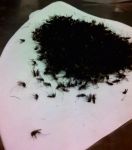How did the summer campaigns go? Here’s what NeAT researchers said about this summer’s work in Greenland and North America:
Northeast Greenland –Tomas Roslin (from University of Helsinki)
At Zackenberg, the summer was late, wet and snowy. To sample arthropods, we used skis until the end of June. A total of five people worked in the valley during different parts of the summer, with our main focus on fungal-plant, host-parasitoid and plant-pollinator interactions. Given the late summer, we miserably failed to implement the background herbivory project (our apologies!), but will try again next year. In the Arctic, no years are brothers…
Yukon – Shaun Turney (PhD student with Chris Buddle, from McGill University)
In July 2015, I studied Arctic arthropods along the Dempster Highway in the Yukon. The Dempster Highway makes a fascinating study system, with a huge amount of variety over a distance that can be driven easily in a day. In the north (67 deg N), the sun shone brightly at all hours, the mosquitoes swarmed, and tree stands looked like bonsai gardens. In the south (65 deg N), we experienced brief twilight nights, ground squirrels were abundant while mosquitoes were scant, and lush forests dominated some of the valleys.
South Greenland –Joe Bowden (from Aarhus University)
Toke T. Høye, myself and a number of others (Aarhus University) headed to Narsarsuaq, South Greenland over the summer in continuation and expansion of our monitoring program. It was a particularly late summer for us as snow was not melted from the mountain tops by the time I left during the final week of June. Oskar LP Hansen, who remained in Narsarsuaq for the summer noted that the rest of the summer was sunny and quite warm and much of the water that had accumulated during melt had vanished.
Alaska –Derek Sikes (from University of Alaska, Fairbanks)
Derek Sikes made short collecting trips to various places in Alaska this summer: Barrow, Galena, and Kantishna (first time for these three sites for me), and in the Aleutians to the islands of Adak, Atka, and Little Tanaga. Barrow is the northern most point in Alaska and a hotbed for climate change research. The last attempt at a comprehensive arthropod inventory of Barrow was published by Hurd in 1958.

